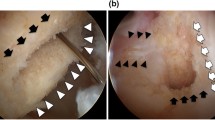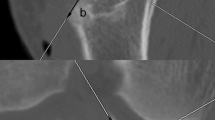Abstract
Purpose
In animal studies after ACL reconstruction (ACL-R) using the bone-patellar tendon-bone (BTB), the graft-healing pattern was found to depend on the relationship between bone plug and the tunnel wall. This difference of graft-healing pattern could influence the postoperative morphological changes of the tunnel. However, no study has assessed the relationship between bone plug position and the change of tunnel morphology. Therefore, the main purpose of this study was to investigate the relationship between the bone plug position within femoral or tibial tunnel and morphological changes of each tunnel aperture in ACL-R using computed tomography.
Methods
Subjects were 30 consecutive patients (six females and 24 males; mean age, 20.4 ± 5.4 years) who underwent primary ACL-R using BTB. The distance from the tunnel aperture to the tendon-bone junction (TBJ) at 2 weeks postoperatively, and tunnel aperture enlargement and tunnel wall migration from 2 weeks to 6 months postoperatively, were evaluated.
Results
The distance from the femoral tunnel aperture to the TBJ in most cases was less than 2 mm, whereas the TBJ was located within the tibial tunnel. Femoral tunnel aperture was significantly enlarged (17.0 ± 11.7%) distally, and the tibial tunnel aperture was significantly enlarged (19.6 ± 12.5%) posterolaterally. Only the position at distal portion of femoral bone plug was correlated with femoral tunnel aperture enlargement (r = 0.454, p = 0.0015).
Conclusion
Both femoral and tibial tunnel aperture were significantly enlarged distally and posterolaterally 6 months postoperatively. Only correlation between the position at distal portion of femoral bone plug and femoral tunnel enlargement were found, suggesting the deep plug position in the tunnel is a risk factor for femoral tunnel enlargement, highlighting the importance of accurately locating the TBJ just at the femoral tunnel aperture. Another option is to deviate the harvest site in the patellar tendon to match the shape of the TBJ and the tunnel aperture.
Level of evidence
4 (case series).





Similar content being viewed by others
References
Amano H, Tanaka Y, Kita K, Uchida R, Tachibana Y, Yonetani Y, Mae T, Shiozaki Y, Horibe S (2018) Significant anterior enlargement of femoral tunnel aperture after hamstring ACL reconstruction, compared to bone-patellar tendon-bone graft. Knee Surg Sports Traumatol Arthrosc. https://doi.org/10.1007/s00167-018-5098-9
Araki D, Kuroda R, Matsumoto T, Nagamune K, Matsushita T, Hoshino Y, Oka S, Nishizawa Y, Kurosaka M (2014) Threedimensional analysis of bone tunnel changes after anatomic double-bundle anterior cruciate ligament reconstruction using multidetector-row computed tomography. Am J Sports Med 42(9):223–241
Berg EE, Pollard ME, Kang Q (2001) Interarticular bone tunnel healing. Arthroscopy 17(2):189–195
Bernard M, Hertel P, Hornung H, Cierpinski T (1997) Femoral insertion of the ACL. Radiographic quadrant method. Am J Knee Surg 10(1):14–21 (discussion 21–22)
Burks R (1992) Practical considerations in cruciate graft fixation. Op Tech Orthop 2(12):71–75
Choi NH, Son KM, Yoo SY, Victoroff BN (2012) Femoral tunnel widening after hamstring anterior cruciate ligament reconstruction with bioabsorbable transfix. Am J Sports Med 40Z(2):383–387
Drogset JO, Grøntvedt T, Myhr G (2006) Magnetic resonance imaging analysis of bioabsorbable interference screws used for fixation of bone-patellar tendon-bone autografts in endoscopic econstruction of the anterior cruciate ligament. Am J Sports Med 34(7):1164–1169
Fauno P, Kaalund S (2005) Tunnel widening after hamstring anterior cruciate igament reconstruction is influenced by the type of graft fixation used: a prospective randomized study. Arthroscopy 21(11):1337–1341
Hoigne DJ, Ballmer PM (2010) Influence of the bone block position on the tunnel enlargement in ACL reconstruction. Orthop Rev (Pavia) 20(1):e12 2(
Järvelä T, Moisala AS, Paakkala T, Paakkala A (2008) Tunnel enlargement after double-bundle anterior cruciate ligament reconstruction: a prospective, randomized study. Arthroscopy 24(12):1349–1357
Kusano M, Yonetani Y, Mae T, Nakata K, Yoshikawa H, Shino K (2017) Tibial insertions of the anterior cruciate ligament and the anterior horn of the lateral meniscus: a histological and computed tomographic study. Knee 24(4):782–791
Segawa H, Omori G, Tomita S, Koga Y (2001) Bone tunnel enlargement after anterior cruciate ligament reconstruction using hamstring tendons. Knee Surg Sports Traumatol Arthrosc 9(4):206–210
Shino K, Mae T, Tachibana Y (2015) Anatomic ACL reconstruction: rectangular tunnel/bone-patellar tendon-bone or triple-bundle/semitendinosus tendon grafting. J Orthop Sci 20(3):457–468
Suzuki T, Shino K, Nakagawa S, Nakata K, Iwahashi T, Kinugasa K, Otsubo H, Yamashita T (2011) Early integration of a bone plug in the femoral tunnel in rectangular tunnel ACL reconstruction with a bone-patellar tendon-bone graft: a prospective computed tomography analysis. Knee Surg Sports Traumatol Arthrosc 19(Suppl 1):S29–S35
Tachibana Y, Mae T, Shino K, Kanamoto T, Sugamoto K, Yoshikawa H, Nakata K (2015) Morphological changes in femoral tunnels after anatomic anterior cruciate ligament reconstruction. Knee Surg Sports Traumatol Arthrosc 23(12):3591–3600
Taketomi S, Inui H, Sanada T, Yamagamai R, Tanaka S, Nakagawa T (2014) Eccentric femoral tunnel widening in anatomic anterior cruciate ligament reconstruction. Arthroscopy 30(6):701–709
Thomas NP, Kankate R, Wandless F, Pandit H (2005) Revision anterior cruciate ligament reconstruction using a 2-stage technique with bone grafting of the tibial tunnel. Am J Sports Med 33(11):1701–1709
Tomita F, Yasuda K, Mikami S, Sakai T, Yamazaki S, Tohyama H (2001) Comparisons of intraosseous graft healing between the doubled flexor tendon graft and the bone-patellar tendon-bone graft in anterior cruciate ligament reconstruction. Arthroscopy 17(5):461–476
Tsuda E, Ishibashi Y, Fukuda A, Yamamoto Y, Tsukada H, Ono S (2010) Tunnel position and relationship to postoperative knee laxity after double-bundle anterior cruciate ligament reconstruction with a transtibial technique. Am J Sports Med 38(4):698–706
Tsukada H, Ishibashi Y, Tsuda E, Fukuda A, Toh S (2008) Anatomical analysis of the anterior cruciate ligament femoral and tibial footprints. J Orthop Sci 13(2):122–129
Uchida R, Toritsuka Y, Mae T, Kusano M, Ohzono K (2016) Healing of tibial bone tunnels after bone grafting for staged revision anterior cruciate ligament surgery: a prospective computed tomography analysis. Knee 23(5):830–836
Webster KE, Feller JA, Hameister KA (2001) Bone tunnel enlargement following anterior cruciate ligament reconstruction: a randomised comparison of hamstring and patellar tendon grafts with 2-year follow-up. Knee Surg Sports Traumatol Arthrosc 9(2):86–91
Xu Y, Ao Y, Wang J, Yu J, Cui G (2011) Relation of tunnel enlargement and tunnel placement after single-bundle anterior cruciate ligament reconstruction. Arthroscopy 27(7):923–932
Yoshiya S, Nagano M, Kurosaka M, Muratsu H, Mizuno K (2000) Graft healing in the bone tunnel in anterior cruciate ligament reconstruction. Clin Orthop Relat Res 376:278–286
Funding
No author or related institution has received any financial benefit from research in this study.
Author information
Authors and Affiliations
Corresponding author
Ethics declarations
Conflict of interest
The authors declare that they have no conflict of interest.
Ethical approval
IRB approval was obtained (Seifu hospital, approval ID: 25-1).
Informed consent
All patients gave informed consent for study inclusion.
Rights and permissions
About this article
Cite this article
Uchida, R., Shiozaki, Y., Tanaka, Y. et al. Relationship between bone plug position and morphological changes of tunnel aperture in anatomic rectangular tunnel ACL reconstruction. Knee Surg Sports Traumatol Arthrosc 27, 2417–2425 (2019). https://doi.org/10.1007/s00167-018-5224-8
Received:
Accepted:
Published:
Issue Date:
DOI: https://doi.org/10.1007/s00167-018-5224-8




